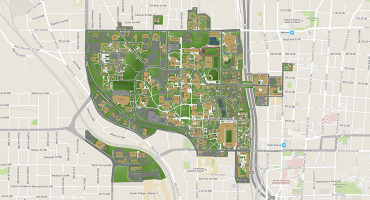This story, written by Bryant Wine, originally appeared on the College of Computing website.
Georgia Tech scientists, including a researcher from the School of Biological Sciences, have formed the core of an interdisciplinary, inter-organizational team which seeks to prevent disease outbreaks by integrating the study of human behavior with computational data-driven models.
Calling themselves BEHIVE (BEHavioral Interaction and Viral Evolution), the group recently received a $1 million National Science Foundation (NSF) grant toward multidisciplinary team formation and novel outbreak prevention research.
“Our goal is to bring together all these terrific researchers from different disciplines to help bring a paradigm shift in the science of pandemic prediction and prevention,” said B. Aditya Prakash, associate professor with Georgia Tech’s School of Computational Science and Engineering (CSE).
“While epidemic forecasting is compared to weather forecasting, there is an important difference. Unlike weather, our actions and behavior can change the course of an epidemic.”
Prakash is the principal investigator of the $1 million NSF grant. Fellow BEHIVE members include:
- Pinar Keskinocak, William W. George Chair and Professor in the H. Milton Stewart School of Industrial and Systems Engineering at Georgia Tech
- Thomas Kingsley, Assistant Professor of Medicine and Biomedical Informatics at Mayo Clinic
- Shinobu Kitayama, Robert B. Zajonc Collegiate Professor of Psychology at the University of Michigan
- Ramesh Raskar, Associate Professor at the Massachusetts Institute of Technology Media Lab
- Liliana Salvador, Assistant Professor at the University of Georgia’s Department of Infectious Diseases
- Joshua Weitz, Professor and Tom and Marie Patton Chair in the School of Biological Sciences and Co-Director of the Interdisciplinary Ph.D. in Quantitative Biosciences (QBioS) at Georgia Tech
Prakash emphasized BEHIVE’s primary goal to use its interdisciplinary organization to bridge research methodologies between hard and soft sciences.
He explained that human behavior was underutilized in epidemic science before Covid-19, largely due to data scarcity and underdeveloped computational technologies. Behavioral dynamics encountered during the pandemic, such as social distancing, mask wearing, and vaccine hesitancy, has provided new research and data that now can be considered in models and simulations.
Here, BEHIVE will develop high fidelity computational models by designing new artificial intelligence and machine learning techniques that bridge human behavior knowledge and traditional epidemiological theory and models.
“It is still an open question of how we can best incorporate human behavior knowledge into the study of pandemics. That is the challenge,” Prakash said. “Our main idea is to better integrate knowledge from psychology and the humanities into pandemic science using novel computational methods.”
BEHIVE originated when team members met through various workshops held in 2020 and 2021. Prakash was an invited organizer of the National Symposium on Predicting Emergence of Virulent Entities by Novel Technologies (PREVENT).
PREVENT reported that interdisciplinary collaboration was an obstacle in predicting and preventing pandemics. For example, some vocabularies often don’t mean the same thing across disciplines, so a consistent methodology to establish a common language must be developed.
BEHIVE is custom built to solve these challenges PREVENT revealed. Along with a wealth of knowledge learned through past epidemics, each BEHIVE researcher brings to the group experience working across interdisciplinary lines.
Among the Georgia Tech researchers alone, Keskinocak interfaced with policymakers and the public on measures to slow Covid-19's spread.
Prakash’s lab led several high-profile Covid-19 forecasting initiatives, including collaboration with the Center for Disease Control and Prevention (CDC).
Weitz teamed with fellow Georgia Tech researchers in the College of Sciences, College of Computing, and the Wallace H. Coulter Department of Biomedical Engineering to create a predoctoral training program that integrates computational modeling and data analytics into bioscience.
Keskinocak, Prakash, and Weitz together are also faculty in the Institute for Data Engineering and Science (IDEaS), one of Georgia Tech’s ten interdisciplinary research institutes. IDEaS connects research centers and efforts in foundational areas such as machine learning, high-performance computing, and algorithms.
BEHIVE’s $1 million grant is funded through NSF’s Predictive Intelligence for Pandemic Prevention (PIPP) initiative. This program supports high-risk, high-payoff convergent research that aims to identify, model, predict, track, and mitigate the effects of future pandemics.
According to Prakash, the PREVENT symposium’s summary report also helped highlight the need for an initiative like PIPP.
PIPP is a two-phased initiative in which NSF selects to fund 25 to 30 project teams, including BEHIVE, for eighteen months through phase one. However, this does not necessarily limit PIPP’s influence to chosen project teams within academia.
BEHIVE intends to partner with industry, governmental, and non-profit organizations to expand its interdisciplinary, interorganizational network.
BEHIVE’s nucleus of Georgia Tech researchers connects the group with the CDC, Georgia Department of Public Health, and numerous hospitals across the state. BEHIVE’s other researchers also serve in leading roles at non-profits, such as the Pathcheck Foundation, and top hospitals like the Mayo Clinic.
Along with developing interdisciplinary methodologies, new disease prevention models, and partnering with external organizations, BEHIVE hopes to develop educational training programs. This would ensure their effort last generations to bring about the necessary paradigm change to prevent future pandemics.
“Our initial projects and research the next eighteen months will help us get a sense of research gaps and enlarge our perspective” Prakash said. “We’re approaching PIPP as a science, and we want to lay the foundation of the science by bringing in many people from different fields for the future.”



